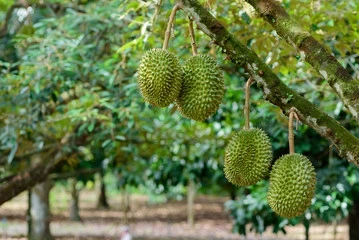Durian is often called the "king of fruits" due to its distinctive sweet taste and unique, strong aroma. Yet, many people have been disappointed by this exotic fruit because they encountered a poor-quality durian—either unripe or with damaged flesh.

Choosing a ripe durian is undoubtedly a challenge. But don't worry, there are a few simple tips that will help you.
1. Pay attention to the shape and size of the fruit.
The shape of the durian can indicate the quality of its contents. Choose a durian that is round or slightly oval, as it usually has more flesh and fewer seeds.
Symmetrical durians generally have more flesh compared to those that are deformed or dented. Additionally, consider the size of the durian—larger durians generally have more flesh.

2. Examine the spikes on the durian's skin.
The spikes on a durian's skin can give clues about its taste and quality. Choose durians with short and sparse spikes—they are generally sweeter. On the other hand, long and dense spikes often indicate that the durian contains less flesh. Hard and sharp spikes are a sure sign that the durian is perfectly ripe.
3. Check the durian's stem
The stem of the durian is another important indicator of the fruit's ripeness. Choose durians with short and thick stalks, as this allows better nutrient flow into the fruit. A dry or dark stem may indicate that the durian stayed on the tree for too long. If the stem looks juicy and moist, it is a good sign that the durian is still fresh. There should be no knife marks on the stem; it's better when the ripe fruit falls from the tree naturally.

4. Smell the durian
Aroma is one of the best ways to assess the quality of a durian. A ripe durian will emit a sweet and fragrant smell. Try smelling the bottom of the fruit—if the aroma is strong, the flesh inside is likely of good quality. However, if the aroma is too strong (with durian, you definitely won't mistake it) - it may mean that the fruit is overripe or even spoiled.
5. Listen to the sound when tapping
The same principle applies as when choosing watermelons during a European summer. A ripe durian makes a hollow sound, indicating that the flesh inside is soft and ready to eat. If the sound seems hard and filled, the fruit is likely still tough and unripe.
6. Look at the color of the durian's skin.
The color of the skin can also be an indicator of ripeness. A ripe durian should have yellow or yellowish skin. Avoid buying durians with dark or too pale skin as it may indicate that the fruit is unripe or too old.

7. Do not buy durians with split skins.
A durian with already open skin may be a result of forced ripening, making its taste bland. It’s better to choose durians with intact skin to ensure the quality of the flesh inside.
Happy and tasty durian hunting!

You can add one right now!